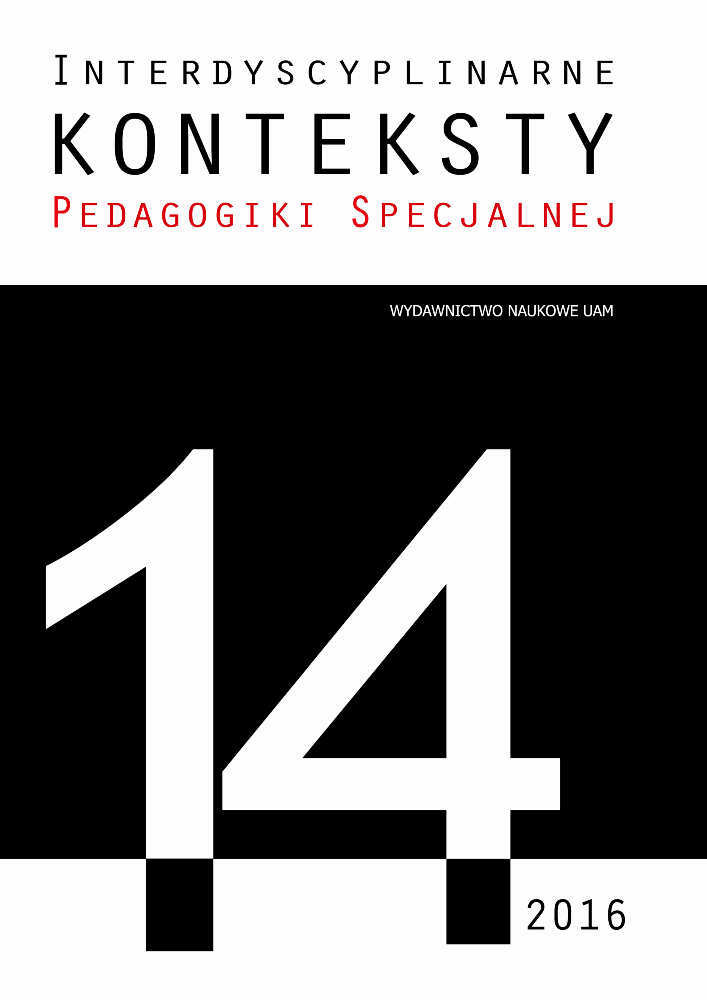Abstrakt
Gestures and facial expressions appear in child communication before she/he is able to say the first word, and their qualitative and quantitative growth is considered an indicator of future language development. The aims of this article is review of the research available in literature on the use of gestures in the communication process of children whose development is typically and children with developmental disorders. There is an evidence that the differences in the development of gestures communication in children with typical and atypical development allow to predict potential language delays.Bibliografia
Acredolo L., Goodwyn S., Symbolic gesturing in normal infants, “Child Development” 1988, 59.
Botting N., Riches N., Gaynor M., Morgan G., Gesture production and comprehension in children with specific language impairment, “British Journal of Developmental Psychology” 2010, 28.
Brady N., Marquis J., Fleming K., McLean L., Prelinguistic predictors of language growth in children with developmental disabilities, “Journal of Speech, Language, and Hearing Research” 2004, 47.
Bruner J.S. 1980, Ontogeneza aktów mowy, [w:] Badania nad rozwojem języka dziecka, G. red. W. Shugar, M. Smoczyńska, PWN, Warszawa 1980.
Capone N.C. Tapping toddlers’ evolving semantic representation via gesture, “Journal of Speech, Language, and Hearing Research” 2007, 50.
Capone N.C., McGregor K.K., Gesture development: a review for clinical and research practices, “Journal of Speech, Language, and Hearing Research” 2004, 47.
Carpenter R.L., Mastergeorge A.M., Coggins T.E. The acquisition of communicative intentions in infants eight to fifteen months of age, “Language and Speech” 1983, 26(2).
Caselli M.C. i in., Gestures and word in early development children with Down Syndrome, “Journal of Speech, Language, and Hearing Research” 1998, 41.
Cook S.W., Goldin-Meadow S., The role of gesture in learning: Do children use their hands to change their minds?, “Journal of Cognition and Development” 2006, 7(2).
Crais E., Douglas D.D., Campbell Ch.C., The intersection of the development of gestures and intentionality, “Journal of Speech, Language, and Hearing Research” 2004, 47.
Crais E.R., WatsonL. R., Baranek G.T., Use of gesture development in profiling children’s prelinguistic communication skills, “American Journal of Speech-Language Pathology” 2009, 18.
Goldin-Meadow S., Beyond words: The importance of gesture to researchers and learners, “Child Development” 2000, 71(1).
Goldin-Meadow S., Gesture’s role in the learning process, “Theory into Practice” 2004, 43(4).
Goldin-Meadow S., How gesture promotes learning throughout childhood, “Child Development Perspectives” 2009, 3(2).
Goldin-Meadow S., Goodrich W., Sauer E., Iverson J., Young children use their hands to tell their mothers what to say, “Developmental Science” 2007, 10(6).
Halliday M.A.K., Uczenie się znaczeń, [w:] Badania nad rozwojem języka dziecka, red. G.W. Shugar, M. Smoczyńska, PWN, Warszawa 1980.
Iverson J.M., Goldin-Meadow S., Gesture paves the way for language development, „Psychological Science” 2005, 16(5).
John A.E., Mervis C.B., Comprehension of the communicative intent behind pointing and gazing gestures by young children with Williams Syndrome or Down Syndrome, “Journal of Speech, Language, and Hearing Research” 2010, 53.
Liszkowski U., Carpenter M., Striano T., Tomasello M., 12- and 18-month-olds point to provide information for others, “Journal of Cognition and Development” 2006, 7(2).
Namy L.L., Newcombe N.S., More than just hand waving: Review of Hearing Gestures: How our hands help us think, “Journal of Cognition and Development” 2008, 9(2).
Paavola L., Kemppinen K., Kumpulainen K., Moilanen I., Ebeling H., Maternal sensitivity, infant co-operation and early linguistic development: Some predictive relations, “European Journal of Developmental Psychology” 2006, 3(1).
Rowe M.L., Goldin-Meadow S., Early gesture selectively predicts later language learning, “Developmental Science” 2009, 12 (1).
Sauer E., Levine S.C., Goldin-Meadow S., Early gesture predicts language delay in children with pre- or perinatal brain lesions, “Child Development” 2010, 81(2).
Smith I.M., Bryson S.E., Gesture imitation in autism: II. Symbolic gestures andpantomimed object use, “Cognitive Neuropsychology” 2007, 24(7).
Schaffer H.R., Rozwój języka w kontekście, [w:] Dziecko w zabawie i świecie języka, red. A. Brzezińska i in., Zysk i S-ka, Poznań 1995.
Shumway S., Wetherby A.M., Communicative acts of children with autism spectrum disorders in the second year of life, “Journal of Speech, Language, and Hearing Research” 2009, 52.
Watt N., Wetherby A., Shumway S., Prelinguistic predictors of language outcome at 3 years of age, “Journal of Speech, Language, and Hearing Research” 2006, 49.
Zambrana I.M., Ystrom E., Schjølberg S., Pons F., Action imitation at 1½ years is better than pointing gesture in predicting late development of language production at 3 years of age, “Child Development” 2013, 84(2).

